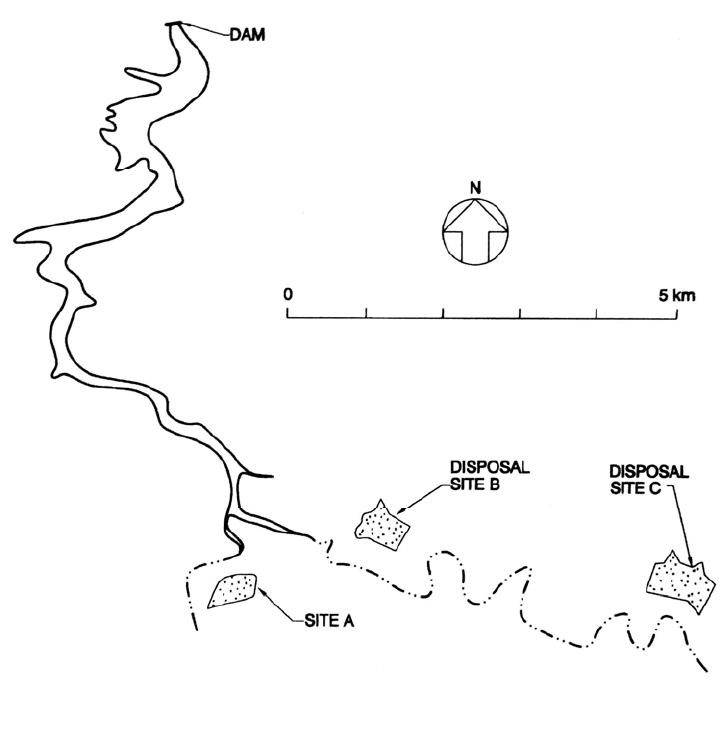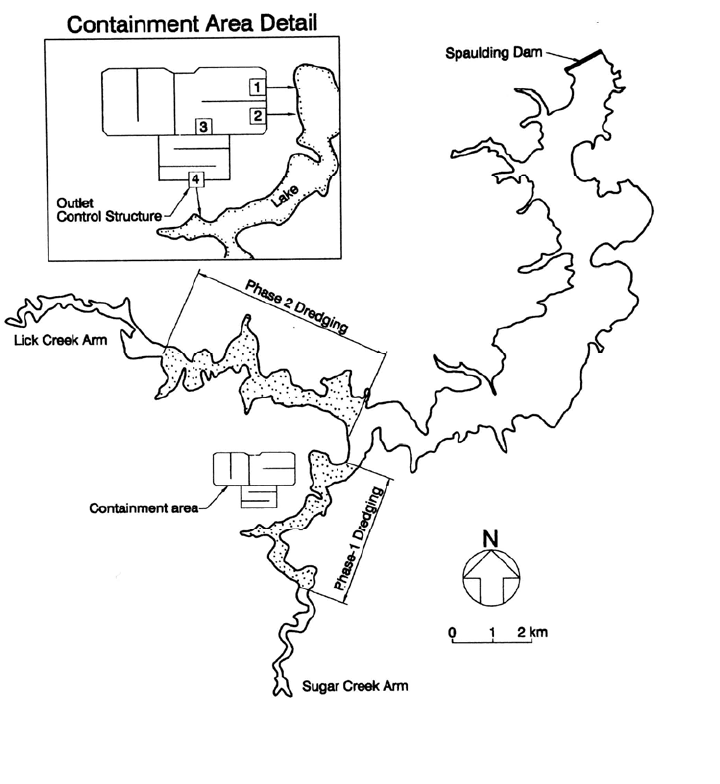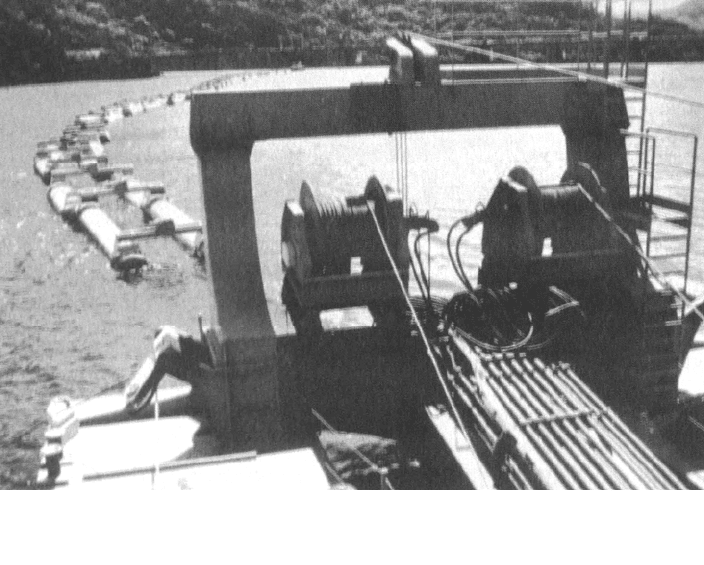Morris & Fan. Reservoir Sedimentation Handbook
Подождите немного. Документ загружается.

SEDIMENT EXCAVATION 16.16
This merely moves the sediment problem from one place to another. Sediment deposition
can cause the riverbed to aggrade and overflow its banks, obstruct water supply and
irrigation intakes, increase treatment costs at water filtration plants, clog permeable river
beds supplying infiltration galleries, and impair recreational and aesthetic uses. In
addition, the clogging of coarse bed material with fine sediment can severely affect or
destroy aquatic ecosystems. Sedimentation within the downstream channel should be
expected to be particularly severe in relatively low-gradient streams where sediment
accumulation has already become a problem because of the reduction in peak
downstream discharges following dam construction.
In some cases sediment discharge to the river below the dam may be a logical
alternative, especially if undertaken as a continuous long-term process which matches
sediment discharge below the dam to the rate of sediment inflow. However, the
consequences of discharge below the dam should always be analyzed very carefully
because of the large downstream impacts which can be caused. This analysis will rely
heavily on a responsible environmental impact analysis, since the negative below-dam
impacts will typically affect third parties, while the owner of the dam reaps the economic
benefits. The authors have not yet found an example of a detailed monitoring study
examining the impacts of the discharge of dredged material below a dam.
Off-Stream Disposal. For off-stream disposal, hydraulically dredged sediment is
pumped into an upland diked containment area where the sediments are allowed to settle,
and the supernatant water is discharged into the environment (often back into the lake
being dredged). After dredging ends, the containment area is dewatered, sediments are
allowed to dry, and the site is (1) dedicated to a new use or (2) reused for additional
future sediment deposition by either heightening dikes or excavating the dried sediments.
In some cases it might be feasible to dam a shallow tributary arm of the reservoir,
discharging sediment into that area and filling it well above the reservoir level.
A number of criteria in addition to the lease or purchase price will be important to
consider in selecting an off-stream disposal site:
1. Provide adequate volume to store the dredged material following bulking and
adequate surface area for solids settlement to meet the effluent standards, based on
the settling characteristics of the sediment.
2. For economy, the disposal site should be located as near as possible to the area to be
dredged and close to the lake elevation. However, nearby disposal sites are not
always available.
3. Limit the cost of dikes by selecting a site with favorable topography and suitable
borrow material for dike construction. The construction of containment area diking is
a potentially large cost item.
4. Avoid areas considered environmentally sensitive such as wetlands and streams,
historical sites, and river floodway. As an exception, it may be feasible to impound a
tributary stream, subsequently converting the containment area into a wetland with a
permanent drop structure.
5. Minimize adverse hydrologic impacts. To minimize impacts on the lake's water
budget, the settled effluent from the disposal area should drain back into the
reservoir. Avoid areas where seepage from the containment area can cause an
undesired increase in groundwater levels, or provide for remedial measures such as
drains.
6. Isolate the site from urban areas where the disposal dikes, pipelines, and other
equipment may be considered a nuisance, a safety hazard, aesthetically unpleasant,
and may conflict with existing zoning, roads, and rights-of-way.

SEDIMENT EXCAVATION 16.17
7. In arid regions, consider the long-term impacts of wind-blown silt that can originate
from the disposal area after it dries.
8. The site should provide the operational flexibility needed for the job, such as the
ability to discharge dredged material at different points as the dredge moves.
9. The site should be suitable for future reuse.
The large volumes of sediment associated with major dredging work can represent a
difficult siting problem, and the "best" site may not be optimal from the standpoint of all
the above criteria. The locations of disposal sites selected for the discharge of 6 Mm
3
of
hydraulically dredged sediment from Loiza Reservoir are illustrated in Fig. 16.11.
Because of topographic limitations and the presence of river floodways, urban land uses,
wetlands, and other restrictions, these were the closest feasible sites. Contrast this to the
siting that was possible at Lake Springfield (Fig. 16.12).
16.4.5 Long-Term Use and Sustainable Dredging
If a reservoir is dredged once, it will probably need to be dredged again. Dredging
represents a long-term management alternative only as long as disposal sites are
available.
FIGURE 16.11 Location of disposal areas for 6 Min' of sediment to be dredged from Loíza
Reservoir, Puerto Rico.

SEDIMENT EXCAVATION 16.18
.
FIGURE 16.12 Location and layout of disposal areas used for 2.3 Mm
3
of sediment dredged fro
m
Lake Springfield, Illinois
The need for repeated future dredging should be carefully considered in the selection and
design of a spoil area, providing the option for future reuse of the site insofar as possible.
Site reuse can be achieved by excavating and trucking the dredged material after it has
dewatered, or by raising the dikes. Disposal area reuse has been discussed by
Montgomery et al. (1978).
Containment areas are often dedicated to agricultural use after a year or two of
dewatering. Containment areas may also be converted into a natural or parkland area.
When wet or ponded, containment areas have rapidly developed wetland vegetation and
become significant wildlife habitats.
16.4.6 Dredging Contracts
General considerations for dredging contracts have been reviewed by Sanderson (1992).
Dredging is normally performed under one of three types of contract forms. A unit price
contract is based on measurement of the volume of material removed, and payment is
based on this measurement. A rental contract pays for the number of hours the dredge is
in operation, with additional payment schedules for idle, standby, and moving time.
SEDIMENT EXCAVATION 16.19
Contract specifications in this case should give considerable attention to the capacity and
condition of the dredging equipment. The least-used type of dredging contract is a lump
sum contract which specifies the work to be performed for a fixed price within a stated
time period.
Sanderson has observed that contracts and the pre-contracting process are almost
always given less attention than they deserve, and many disputes could be avoided by
more careful preparation of contracts and specifications. Several recurrent issues in the
preparation and administration of dredging contracts were identified.
1. Differing Site Conditions. Dredging involves the excavation of unseen material,
and the conditions encountered during the work may be different from those expected by
either the owner or the contractor during the contracting phase. There is a high potential
for unforeseen conditions to arise, leading to claims for differing site conditions.
In preparing specifications for dredging work, the recommended procedure is to
provide a detailed description of the field testing performed, and the results of that
testing. Other known conditions which may affect the work should be factually presented
(e.g., submerged obstructions and anticipated seasonal variations in water level, which
may dramatically affect pumping costs). However, the data presented should not be
interpreted by the owner, least it be interpreted to warrant conditions at the site.
Interpretation should be the bidder's responsibility. Unpredictable water level variation
due to drought is a potentially critical aspect of reservoir dredging, and should be
addressed in the contract. Another potential problem in some sites involves debris, which
may be concentrated in certain areas of a reservoir and may not be detected during
sampling.
2. Records. From the standpoint of contract administration, a singularly important
task is the proper documentation of the facts relating to work progress, and a factual
description of the nature of any problems encountered. The contractor should maintain a
daily log of dredging operations, and the owner should prepare inspection reports on a
regular basis. Good field records form the essential basis for the settlement of subsequent
claims and disputes which may arise on the job.
3. Authority. The contract documents typically establish specific individuals who
shall serve as the owner's and contractor's representative for issues relating to contract
decisions and notifications, and certain types of decisions can be made only with persons
having the proper legal authority. For example, an inspector may be authorized only to
make reports and lack authority to require any type of operational change. Both the
contractor and owner must understand and rigorously follow the procedures and chain of
command established in the contract documents.
4. Corps of Engineer Contracts. As the largest contractor of dredging services in the
United States, the Corps of Engineers is recognized as the premier authority on dredging
matters. The Corps exerts a strong influence on the standards of industry practice, and
thereby will influence the manner in which private dredging contracts may be
subsequently interpreted by arbitrators or the court. Private dredging contracts should
adhere to the Corps principles wherever possible in the writing and interpretation of
contract clauses. Copies of dredging contracts may be obtained from Corps of Engineers
offices, or a complete set of Federal Acquisition Regulations may be obtained from the
Superintendent of Documents.
5. Dispute Resolution. Recourse to litigation for resolving disputes is both time-
consuming and very costly. In response, voluntary alternative dispute resolution
techniques have emerged. Mediation-based techniques use the intercession of a third
party to help the parties reach a mutually satisfactory agreement. Mediation works best
when the two parties desire to continue a business relationship. Arbitration-based

SEDIMENT EXCAVATION 16.20
techniques are more formal than mediation, but faster and less formal than litigation.
Under arbitration the dispute is submitted to a third party or a panel that reviews the
evidence and arguments presented, and renders a decision. Arbitration proceedings are
private and the matter and settlement is confidential. Although arbitration is voluntary,
the parties may agree to binding arbitration, and it may be made a condition of the
contract using an arbitration clause:
Any controversy or claim arising out of or relating to this contract, or the breach
thereof, shall be settled by arbitration in accordance with the Commercial
Arbitration Rules of the American Arbitration Association, and judgment upon the
award rendered by the arbitrator(s) may be entered in any court having jurisdiction
thereof.
Information on both mediation and arbitration may be obtained from The American
Arbitration Association (www.adr.org
), 1633 Broadway, 10th Floor, New York, New
York 10019.
16.4.7 Permit Requirements
The following list of permits is based on those required for the Lake Springfield
dredging, described in the next section. These are typical of the permits required in the
United States for dredging in waters classified as nonnavigable with sediment discharge
to an upland area.
• Army Corps of Engineers. A dredging permit was not required because the reservoir is
not classified a navigable waterway. A nationwide permit was obtained for disposal of
hydraulic dredged material to an upland area. As part of the Army permit, a cultural
resources study was required in the proposed containment area. Depending on the site
characteristics, a jurisdictional determination may be required at the spoil area site to
determine the extent of wetland areas to be affected by the fill activity, and thus subject
to permitting.
• Environmental Protection Agency. A water quality permit was required from the
state, which has primacy under the National Pollution Discharge Elimination System.
The disposal site was considered a treatment system and the effluent was limited to a
maximum suspended-solids concentration of 15 mg/L. The lake sediments to be dredged
had objectionable levels of pesticides, which had washed into the lake with topsoil from
farms in the catchment area. There was concern that dredging would cause these
pesticides to be released, and the water quality permit required biweekly monitoring of
selected pesticides in the disposal area supernatant. Concentrations never exceeded the
detection limit.
• State. A state dam safety permit was required for the spoil embankment, which was
classified under Illinois regulations as a Class 1 site because of its proximity to a
residence.
• Local. It was necessary to change the zoning classification of the site from agricultural
to landfill because of the presence of pesticides in the dredged sediments, even though
the dredged material had lower pesticide levels than the farmland it covered or the
adjacent fields.
The permit issued by the Army Corps of Engineers encompasses the permitting
requirements of and review by that agency plus the Environmental Protection Agency,
the Fish and Wildlife Service, and National Marine Fisheries Service. Endorsement by
the State Historic Preservation Office is also required, based on an assessment of the site
to determine the presence or absence of cultural resources.

SEDIMENT EXCAVATION 16.21
Permitting requirements will be more complex when navigational waterways are
involved, when sediments affect significant wetland areas (which will typically require
development and implementation of a mitigation plan), when threatened or endangered
species are present, where toxic sediments may be involved as may occur in urban lakes,
or under similar complicating situations. Preparation of a full environmental impact
statement may be anticipated for large dredging jobs or those considered to have
potentially significant impacts.
16.5 EXAMPLES OF RESERVOIR DREDGING
16.5.1 Lake Springfield, Illinois
Predredging conditions at Lake Springfield were summarized by Bhowmik et al. (1988),
and the initial phase of dredging was described by Buckler et al. (1988). Built in 1934,
Lake Springfield supplies municipal drinking water to the City of Springfield, Illinois,
and cooling water to the city's thermoelectric power plant. It is a shallow 1635-ha
impoundment on the Sugar Creek tributary to the Sangamon River, extensively used for
recreation, and has about 700 residences around its periphery. The lake has a tributary
area of 686 km
2
, and its original capacity was 73.9 Mm
3
for an average depth of only 4.5
m. By 1984, the capacity had been reduced by about 13 percent, a storage loss of about
9.5 Mm
3
.
Sediment accumulation not only reduced storage volume, but also impaired
recreational use, rendering some boat ramps and the two principal arms of the reservoir
inaccessible to boats and fishermen. Lake fishing contributed an estimated $1.1 million
annually to the community's economy. Property values adjacent to the area with greatest
sedimentation were reduced some 20 percent compared to similar properties on the main
body of the lake. The major benefits of reservoir dredging in the tributary arms of the
reservoir where recreational and property values were most impaired were identified as:
1. Restoring sediment trapping capacity in upper arms of the lake, thereby protecting
the main body of the lake from sedimentation
2. Increase water storage by 2.3 Mm
3
3. Reclamation and reuse of high-quality eroded topsoil that had accumulated in the
lake
4. Reduction of aquatic plant problems
5. Improved fisheries management, including spawning and desirable aquatic habitat
development
6. Increased recreational use such as pleasure boating, water skiing, and fishing
Recovery of full lake capacity was not contemplated because of high cost.
Nineteen candidate upland containment sites were analyzed for sediment disposal on
the basis of proximity to both areas to be dredged; availability of soil suitable for dike
construction; relatively flat topography; proximity to lake level to reduce pumping head;
potential for more than one discharge weir location; and isolation from nearby residences
or infrastructure to minimize safety, nuisance, and right-of-way conflicts for the pipeline
(Buckler et al., 1988). The configuration of the selected 199-ha disposal site is shown in
Fig. 16.12.
SEDIMENT EXCAVATION 16.22
The dredging project was divided into two phases, one for each arm of the reservoir.
Dredging began in 1987, after being delayed by low water which left inadequate depth
under the prescribed cut to float the dredge. Dredging was undertaken 5 days per week,
24 hours per day, from April into December, with a conventional cutterhead-type dredge
and a flexible high-density polyethylene pipeline. Dredging was not feasible in the
middle of winter because the upper arms of the lake ice over. The dredge, booster pump,
pipeline, and other equipment used on this job were transported to the site in 17 tractor-
trailers. A staging area with good road access was provided at the edge of the lake for the
contractor to use for equipment setup and launching, and for storage of equipment and
supplies for the job.
The first dredging phase did not need a booster pump because it was close to the
containment area. The second phase used a single barge-mounted diesel booster pump at
the edge of the lake to pump dredged material into the containment area. Hospital-class
mufflers were specified for the booster, since the lake is lined with residences. Despite
the numerous residences and 24-hour operation, there were no noise complaints during
either phase of the work. Dredging reportedly generated a very small turbidity plume
which caused no problems. Deposited sediments in the lake averaged 66 percent clay, 33
percent silt, and 1 percent sand (Fitzpatrick et al., 1985). Because dredging was
concentrated in the upstream portion of the reservoir the dredged sediment contained
more silts and sands than the main body of the lake.
Because of the variable site topography, containment dikes varied from 1.2 to 7 m in
height. The dikes were originally wide enough to drive around on top, but wave erosion
during the prolonged dredging project subsequently made them too narrow for driving in
some areas. Toe drains were required in some areas to control seepage. The containment
area provided 7 to 14 days of water retention, and was compartmented with outlet
structures at different locations for flexible operation, since the slurry pipe would enter at
different areas depending on the place the dredge was working. Supernatant met the 15-
mg/L effluent standard for suspended solids about 75 percent of the time, problems
occurring primarily when it was windy. Emergent wetland vegetation began to grow as
some of the compartments filled with sediment. It was found that by routing the
supernatant through these shallow vegetated areas prior to discharge, the effluent
turbidity levels were greatly reduced, resulting in turbidities on the order of 1 to 2 mg/L
for prolonged periods. Supernatant from the containment area was discharged back into
the reservoir. In addition to the development of wetland vegetation, the containment area
cells saw extensive use by waterfowl. At the completion of dredging, the containment
area was allowed to dewater and consolidate for 2 years, by which time it was suitable for
agricultural use. The land was then leased to a local farmer for the production of corn and
soybeans (Skelly, 1996).
The project began in 1987 and required 4 years to complete. A total of 2.28 Mm
3
was
dredged at a unit cost of $3.02/m
3
($2.31/yd
3
), which included the cost of purchasing and
constructing the containment area. Project characteristics are summarized in Table 16.2
and costs are summarized in Table 16.3.
16.5.2 Valdesia Reservoir, Dominican Republic
The concrete-gravity Valdesia Dam, a hydropower facility owned by Corporación
Dominicana de Electricidad, was constructed in 1976 approximately 80 km west of Santo
Domingo. Two hurricanes damaged the dam and deposited large volumes of sediment,
which prompted subsequent dredging operations. Information for this example is based
on a site visit in November 1990, including discussions with engineers and operators.

SEDIMENT EXCAVATION 16.23
TABLE 16.2 Summary Characteristics of Lake Springfield Dredging
Phase 1 Phase 2
Dredge pump 1000 hp 675 hp
Booster pump None 1000 hp
Pipeline 35 cm (14 in) 40 cm (16 in)
Pumping distance, km 0.8 to 2.0 1.2 to 3.6
Operation 24 h/day, 6 days/week 24 h/day, 5 days/week
Start June 1987 April 1989
End August 1988 July 1990
Sediment removed, yd
3
1.38X 10
6
yd
3
1.6X 10
6
yd
3
Sediment removed, m
3
1.05 X 10
6
m
3
1.22 X 10
6
m
3
Cost $1.8 million $2.7 million
Source: City of Springfield.
TABLE 16.3 Summary of Dredging Costs, Lake Springfield, Illinois
Item Cost, $
Land purchase 1,272,000
Earthwork, Phase 1 retention area 637,000
Earthwork, Phase 2 retention area 483,000
Phase I dredging 1,800,000
Phase II dredging 2,700,000
Total cost 6,892,000
Unit cost $3.02/m
3
Total volume dredged = 2.28 x 10
6
m
3
.
Source: City of Springfield.
During September 1979 the Dominican Republic was hit by hurricanes David and
Frederick within the space of several days. The radial gates were not opened before the
storm knocked out both sources of power supply, and the unopened gates were
overtopped for 4 days and were destroyed. Large amounts of sediment and debris,
including full-grown trees, washed into the reservoir during the storm and became lodged
against the dam, blocking the bottom sluices. Soundings revealed sediment and debris
accumulations up to 17 m deep within 1 km upstream of the dam. Cranes were used to
grapple material away from the bottom sluice, but even though the bottom sluice would
begin to flow it would become clogged again by more woody debris within a matter of
hours. After several months of work, the attempt to reopen the bottom sluice was
abandoned.
Dredging was undertaken to remove the accumulated sediment, using a 700-mm
siphon dredge, designed by the Italian firm GEOLIDRO, with a hydraulically operated
basket tooth-type cutterhead. This dredge, donated by the Italian government in the form
of international aid, is the largest siphon dredge ever employed in a reservoir (Fig. 16.13).
The discharge line was connected to a circular sluice drilled through the base of the dam;
the hydrostatic head thus discharged silt through the pipeline without the aid of a pump.

SEDIMENT EXCAVATION 16.24
FIGURE 16.13 Discharge line of 700-mm siphon dredge at Valdesia Reservoir, Dominican
Republic. Note that the discharge line is suspended underwater beneath the floats. (G.
Morris.)
Dredging began in November 1988 and continued on a regular basis for 11 months
and on an intermittent basis for the following year. Because of lack of records, the
amount of sediment removed is not known. Intermittent operation was attributed to a
combination of low water level due to drought plus an inadequate inventory of spare parts
(cables, pulleys, etc.). According to the dredge operator, there was relatively little
problem with clogging by woody debris. On two occasions woody debris clogged the
pipeline, which was uncoupled to remove the obstruction. The cutterhead itself was
clogged on a number of occasions, and in each case the cutterhead was lifted, rotation
reversed, and woody material removed by hand. Clogging problems were encountered
only in limited areas of the reservoir most affected by the hurricane-driven debris.
The dredged slurry was discharged directly to the river downstream of the spillway.
The dredged sediments had accumulated in the stream channel below the dam to a
thickness of over a meter and were covered with both wetland and upland vegetation.
Because the power penstock discharges more than 1 km downstream of the dam, dredged
sediments accumulated in the normally dry riverbed below the dam. These sediments
would be scoured and washed downstream only during a flood that produced spillway
discharges. Because the area immediately below the dam is a semiarid zone without
agricultural or other development, a temporary change in the flood level caused by
sediment deposition below the dam is not a critical issue. Downstream irrigation intakes
would also not be affected, since deposited sediments would be scoured only during
major floods.
16.5.3 Bai-Ho Reservoir, Taiwan
Sediment excavation at the 25-Mm
3
Bai-Ho Reservoir in southern Taiwan has been
described by Wang et al. (1995). The reservoir was built in 1965 with a design life of 100

SEDIMENT EXCAVATION 16.25
years, and is used for municipal and irrigation water supply. A high rate of sediment
delivery from the 26.55-km
2
watershed area resulted in an average rate of storage loss of
0.3538 Mm
3
/yr, for a 1.4 percent annual loss. The dam lacks a low-level outlet and
sediment sluicing was not conducted.
Limited volumes of sediment have been removed from this reservoir over a period of
several years by both excavation and hydraulic dredging. Generally, hydraulic excavation
was used near the intake and dry excavation in upper (delta) areas of the reservoir. A
severe drought in 1994 produced extremely low water levels, and this condition was used
to undertake large-scale dry excavation to depths of about 3.3 m over an area of 0.87
km
2
. During the drought an average of 5500 m
3
/day of sediment was removed and
delivered to a disposal site about 2 km from the reservoir with 6 hydraulic backhoes, 2
bulldozers, and 25 trucks. Sediment removal costs are reported in Table 16.4. The large
TABLE 16.4 Sediment Excavation Costs at Bai-Ho Reservoir, Taiwan
Year Type of operation Volume, 1000 m
3
Unit cost, US$/m
3
1991 Hydraulic dredging 35 6.60
1991 Dry excavation 300 6.00
1992 Dry excavation 212 5.40
1992 Hydraulic dredging 42 1.41
1993 Hydraulic dredging 8 4.20
1994 Dry excavation 283 4.30
All years Hydraulic dredging 85 3.80
All years Dry excavation 795 5.24
Source: Wang et al. (1995).
variation reported for hydraulic dredging cost reflects accounting procedures under which
the capital cost of the hydraulic dredge was assigned to some years, whereas only fuel
and labor costs were assigned to other years.
16.6 CONTAINMENT AREA DESIGN
16.6.1 Volume for Initial Storage
The volume of a containment area required for the initial sediment storage volume
includes: (1) the volume occupied by the sediment at the end of dredging and prior to
dewatering; (2) ponding depth, usually about 0.6 m; and (3) freeboard, also typically
about 0.6 m. The volume reserved for sediment storage must be larger than the in situ
sediment volume in the reservoir because of sediment bulking resulting from the
entrainment of water during dredging. Sediment volume must be determined separately
for fine sediment with a high bulking factor and for coarse sediment, which will exhibit
very
little bulking.
The bulking factor is the dimensionless ratio of the volume occupied by the sediment
after deposition in the containment area to the in situ volume of the same material prior to
dredging, as given by:
